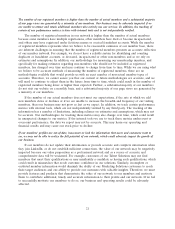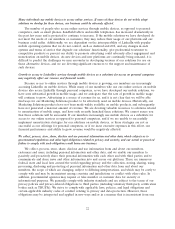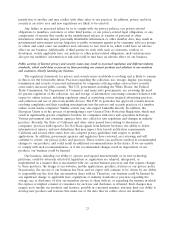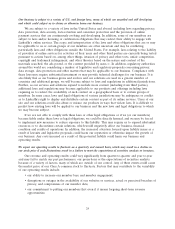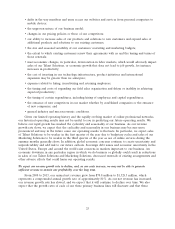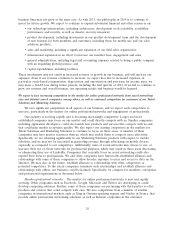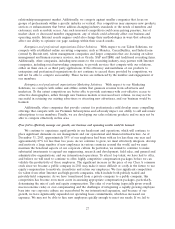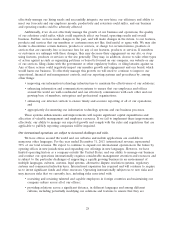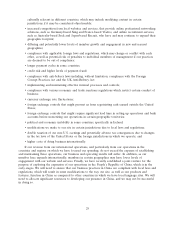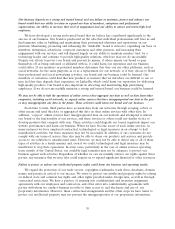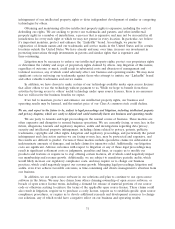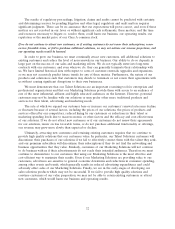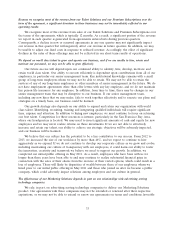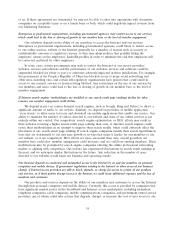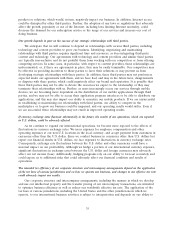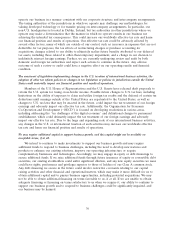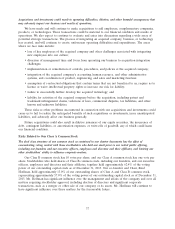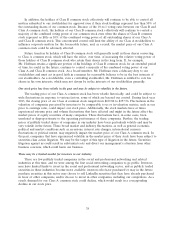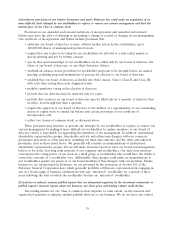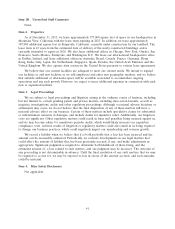LinkedIn 2013 Annual Report Download - page 33
Download and view the complete annual report
Please find page 33 of the 2013 LinkedIn annual report below. You can navigate through the pages in the report by either clicking on the pages listed below, or by using the keyword search tool below to find specific information within the annual report.infringement of our intellectual property rights or deter independent development of similar or competing
technologies by others.
Obtaining and maintaining effective intellectual property rights is expensive, including the costs of
defending our rights. We are seeking to protect our trademarks and patents, and other intellectual
property rights in a number of jurisdictions, a process that is expensive and may not be successful in all
jurisdictions for every such right or which we may not pursue in every location. In particular, we believe
it’s important maintain, protect and enhance the ‘‘LinkedIn’’ brand. Accordingly, we pursue the
registration of domain names and our trademarks and service marks in the United States and in certain
locations outside the United States. We have already and may, over time, increase our investment in
protecting innovations through investments in patents and similar rights that is expensive and
time-consuming.
Litigation may be necessary to enforce our intellectual property rights, protect our proprietary rights
or determine the validity and scope of proprietary rights claimed by others. Any litigation of this nature,
regardless of outcome or merit, could result in substantial costs and diversion of management and
technical resources, any of which could adversely affect our business and operating results. We may incur
significant costs in enforcing our trademarks against those who attempt to imitate our ‘‘LinkedIn’’ brand
and other valuable trademarks and service marks.
In addition, we have chosen to make certain of our technology available under open source licenses
that allow others to use the technology without payment to us. While we hope to benefit from these
activities by having access to others’ useful technology under open source licenses, there is no assurance
that we will receive the business benefits we expect.
If we fail to maintain, protect and enhance our intellectual property rights, our business and
operating results may be harmed, and the market price of our Class A common stock could decline.
We are, and expect in the future to be, subject to legal proceedings and litigation, including intellectual property
and privacy disputes, which are costly to defend and could materially harm our business and operating results.
We are party to lawsuits and legal proceedings in the normal course of business. These matters are
often expensive and disruptive to normal business operations. We are currently facing, or may face in the
future, allegations, lawsuits and regulatory inquiries, audits and investigations regarding data privacy,
security and intellectual property infringement, including claims related to privacy, patents, publicity,
trademarks, copyrights and other rights. Litigation and regulatory proceedings, and particularly the patent
infringement and class action matters we are facing or may face, may be protracted and expensive, and
the results are difficult to predict. Certain of these matters include speculative claims for substantial or
indeterminate amounts of damages, and include claims for injunctive relief. Additionally, our litigation
costs are significant. Adverse outcomes with respect to litigation or any of these legal proceedings may
result in significant settlement costs or judgments, penalties and fines, or require us to modify our
products and features or require us to stop offering certain features, all of which could negatively impact
our membership and revenue growth. Additionally, we are subject to mandatory periodic audits, which
would likely increase our regulatory compliance costs, and may require us to change our business
practices, which could negatively impact our revenue growth. Managing legal proceedings, litigation and
audits, even if we achieve favorable outcomes, is time-consuming and diverts management’s attention from
our business.
In addition, we use open source software in our solutions and plan to continue to use open source
software in the future. We may face claims from others claiming ownership of open source software, or
breach of open source license terms, including a demand for release of material portions of our source
code or otherwise seeking to enforce the terms of the applicable open source license. These claims could
also result in litigation, require us to purchase a costly license, require us to establish specific open source
compliance procedures, or require us to devote additional research and development resources to change
our solutions, any of which would have a negative effect on our business and operating results.
31


